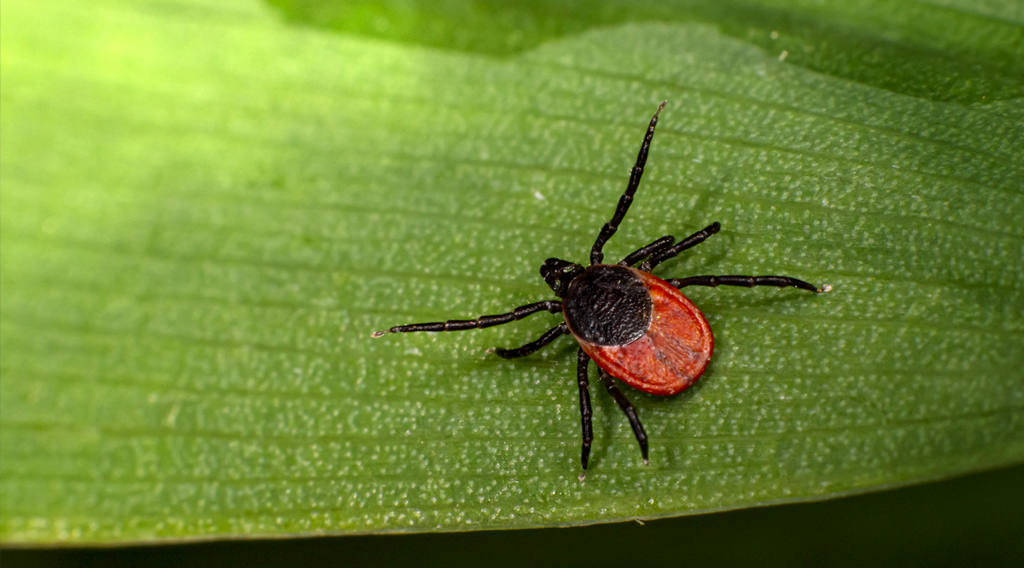May is National Lyme Disease Awareness Month, so we’re offering some basics about the disease—particularly as it impacts Hendricks County. This post also includes symptoms of Lyme disease in people and pets, prevention advice and links to authoritative sources of more detailed information.
About Lyme Disease
Lyme disease is a potentially severe infection caused by the bacterium Borrelia burgdorferi, transmitted to people and pets through bites from an infected blacklegged deer tick. It’s named for Lyme, Connecticut, the town where the disease was first identified in 1975.
According to the Indiana Department of Health, “Lyme disease is the most commonly reported tick-borne disease in Indiana and in the United States.”
While you can’t catch Lyme disease directly from an infected pet, both you and your pet can catch it if you’re bitten by infected blacklegged deer ticks found in the environment you share—on walks you take together in grassy or wooded areas, for example—or from infected ticks brought home and transferred to you from the pet.
Dogs infected with Lyme disease are considered an indicator of the likely exposure of humans to the disease. As a rule, the more dogs testing positive for Lyme disease in a given county, the higher the frequency of Lyme disease in humans living in that county.
Lyme Disease Symptoms
In humans, the early symptoms of Lyme disease infection are an expanding red skin rash, facial nerve and muscle weakness or paralysis, severe headaches and neck stiffness, lightheadedness, flu-like symptoms, fainting, shortness of breath, heart palpitations or chest pains, and pain and swelling in large joints.
As the disease progresses in humans, additional symptoms include fatigue, joint pain, twitching, cognitive impairment, heart problems, neuropathy, headache, muscle aches, memory loss, sleep impairment, gastrointestinal problems, and depression or mood changes.
In dogs, the symptoms of infection—shown by only 5 to 10% of infected dogs—are lameness, fever, joint swelling, lethargy, swollen lymph nodes and loss of appetite. Left untreated, potentially deadly kidney, nervous system and heart problems may develop.
Fortunately, if caught early, most dogs can be successfully treated for Lyme disease with antibiotics. A vaccine is also available.
Lyme Disease in Indiana
The incidence of Lyme disease among humans in Indiana has generally trended upward over the past decade, with a total of 2,523 reported cases since 2017. In 2024, 149 human cases of Lyme disease were reported statewide.
In indiana, Lyme disease is most common in May, June and July, when ticks are most active, but cases have been documented year-round.
Cases of the disease are most prevalent in the northwestern part of the state. The number of reported cases among residents of Hendricks County, while not zero, is relatively low. Four cases were reported in our county in 2024.
The Indiana State Department of Health collected ticks statewide between 2017 and 2024 and had them tested at the Centers for Disease Control and Prevention for the bacterium that causes Lyme disease. Of the 45 adult ticks collected in Hendricks County, none tested positive. Of 26 nymphs collected, one tested positive. However, 20 to 40% of ticks collected in Boone, Putnam, Morgan and Marion counties tested positive and 40% or more of the 66 adult ticks collected in Montgomery County tested positive for the Lyme disease-causing bacterium.
Preventing Lyme Disease
Tick control—primarily by keeping your pet on year-round flea and tick preventive—is the most effective way to prevent Lyme disease infections in pets and people.
Other measures we recommend:
- Avoid areas likely to be infested by ticks when they are most active. In Indiana, that’s late April through May, June and July.
- Ask us which tick repellants are safe to use on your dog.
- Check yourself and your pet thoroughly for ticks immediately after outings to grassy or wooded areas, and remove any you find right away.
We suggest you review “How to Remove a Tick From Your Dog” on the American Kennel Club website before removing ticks.
Ask Us About the Lyme Disease Vaccine
Vaccinated animals are less likely to contract Lyme disease than unvaccinated ones, but it is still possible for a vaccinated animal to be infected.
We recommend the vaccine only for healthy dogs most likely to be exposed to ticks.
After asking you about your pet’s environment and activities and evaluating your pet’s overall health, our veterinarians will help you decide if your pet’s potential exposure to deer ticks warrants a vaccine.
The typical vaccine protocol is an initial injection followed by a booster 2 to 4 weeks later. After that, we recommend annual Lyme disease vaccine boosters.
More Lyme Disease Resources
For comprehensive general information about Lyme disease, visit lymedisease.org. This site is primarily focused on the impact of Lyme disease on humans, but it dedicates a page, “Pets and Lyme disease,” to information of particular interest to pet owners.
On PetMD’s website, see “Lyme Disease in Dogs: Symptoms and Treatment.” The page presents a brief video overview, followed by a more detailed article.
The American Veterinary Medical Association’s “Lyme disease: A pet owner’s guide” offers advice for people as well as pets who may be infected.
For more information about the risk of Lyme disease in cats, see “Lyme Disease: A Potential, But Unlikely, Problem for Cats,” published by Cornell’s Feline Health Center.

